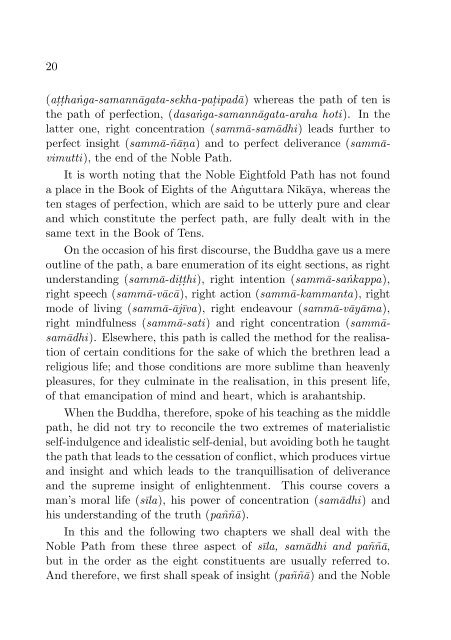Truth and the Way
The Noble Truths and the Way to realise them.
The Noble Truths and the Way to realise them.
Create successful ePaper yourself
Turn your PDF publications into a flip-book with our unique Google optimized e-Paper software.
20<br />
(aṭṭhaṅga-samannāgata-sekha-paṭipadā) whereas <strong>the</strong> path of ten is<br />
<strong>the</strong> path of perfection, (dasaṅga-samannāgata-araha hoti). In <strong>the</strong><br />
latter one, right concentration (sammā-samādhi) leads fur<strong>the</strong>r to<br />
perfect insight (sammā-ñāṇa) <strong>and</strong> to perfect deliverance (sammāvimutti),<br />
<strong>the</strong> end of <strong>the</strong> Noble Path.<br />
It is worth noting that <strong>the</strong> Noble Eightfold Path has not found<br />
a place in <strong>the</strong> Book of Eights of <strong>the</strong> Aṅguttara Nikāya, whereas <strong>the</strong><br />
ten stages of perfection, which are said to be utterly pure <strong>and</strong> clear<br />
<strong>and</strong> which constitute <strong>the</strong> perfect path, are fully dealt with in <strong>the</strong><br />
same text in <strong>the</strong> Book of Tens.<br />
On <strong>the</strong> occasion of his first discourse, <strong>the</strong> Buddha gave us a mere<br />
outline of <strong>the</strong> path, a bare enumeration of its eight sections, as right<br />
underst<strong>and</strong>ing (sammā-diṭṭhi), right intention (sammā-saṅkappa),<br />
right speech (sammā-vācā), right action (sammā-kammanta), right<br />
mode of living (sammā-ājīva), right endeavour (sammā-vāyāma),<br />
right mindfulness (sammā-sati) <strong>and</strong> right concentration (sammāsamādhi).<br />
Elsewhere, this path is called <strong>the</strong> method for <strong>the</strong> realisation<br />
of certain conditions for <strong>the</strong> sake of which <strong>the</strong> brethren lead a<br />
religious life; <strong>and</strong> those conditions are more sublime than heavenly<br />
pleasures, for <strong>the</strong>y culminate in <strong>the</strong> realisation, in this present life,<br />
of that emancipation of mind <strong>and</strong> heart, which is arahantship.<br />
When <strong>the</strong> Buddha, <strong>the</strong>refore, spoke of his teaching as <strong>the</strong> middle<br />
path, he did not try to reconcile <strong>the</strong> two extremes of materialistic<br />
self-indulgence <strong>and</strong> idealistic self-denial, but avoiding both he taught<br />
<strong>the</strong> path that leads to <strong>the</strong> cessation of conflict, which produces virtue<br />
<strong>and</strong> insight <strong>and</strong> which leads to <strong>the</strong> tranquillisation of deliverance<br />
<strong>and</strong> <strong>the</strong> supreme insight of enlightenment. This course covers a<br />
man’s moral life (sīla), his power of concentration (samādhi) <strong>and</strong><br />
his underst<strong>and</strong>ing of <strong>the</strong> truth (paññā).<br />
In this <strong>and</strong> <strong>the</strong> following two chapters we shall deal with <strong>the</strong><br />
Noble Path from <strong>the</strong>se three aspect of sīla, samādhi <strong>and</strong> paññā,<br />
but in <strong>the</strong> order as <strong>the</strong> eight constituents are usually referred to.<br />
And <strong>the</strong>refore, we first shall speak of insight (paññā) <strong>and</strong> <strong>the</strong> Noble
















